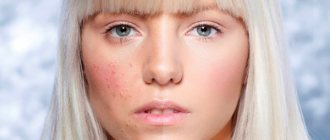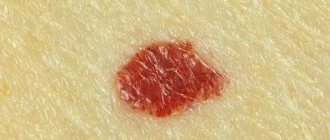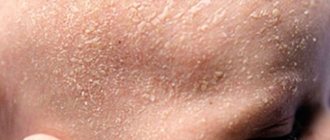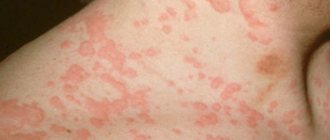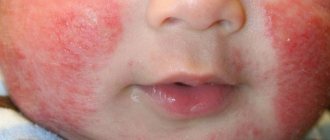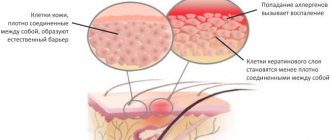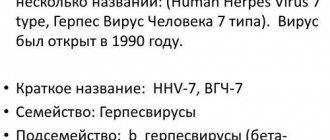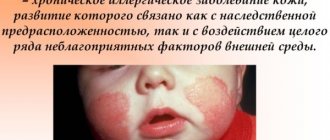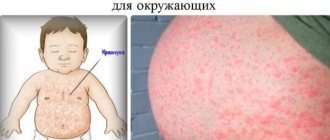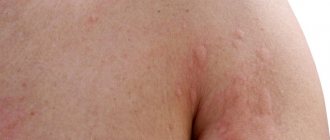Allergic dermatitis cannot be called a rare disease. Moreover, every year it expands its area of influence, since the environment, for objective and subjective reasons, becomes less friendly for humans, food and drink lose traditional natural ingredients and are “enriched” with new, artificial additives, which the body often accepts with hostility "
Allergic dermatitis has been assigned a code according to ICD-10 (the abbreviation means a medical classifier used in many countries around the world) - L23. People of any age and gender are susceptible to the disease.
Diagnosis is quite difficult, because allergic dermatitis is not an immediate reaction of the body to any irritant. It takes weeks, months, and sometimes years for signs of illness to become apparent, so determining the root cause (food, chemical, sun or cold) is not so easy.
Symptoms
In different people, depending on the severity of the disease, symptoms appear with varying degrees of intensity, but practically boil down to the following:
- swelling;
- spots of different sizes and shapes, single or multiple, red or pink;
- the appearance of papules filled with liquid;
- the appearance of weeping skin areas vulnerable to microbes;
- itching and burning.
Sores often form on the inflamed surface, and when they dry out, scales and crusts appear . Even when the disease recedes, its consequences remain in the form of thickened skin, peeling and dryness.
Depending on the form of dermatitis, different areas are affected. The rash appears on the elbows, knees (mainly on the folds), legs, buttocks, groin, labia, and back.
Symptoms
There are mandatory symptoms of dermatitis that are the same for all types of the disease:
- Itching - intensity depends on the degree of irritability of the nerve endings.
- Redness is erythema in which the dermal capillaries become excessively filled with blood. By pressing on the area of hyperemia, you can determine pallor.
- Rashes - eczema, localized over the joints, face, scalp, sides of the body, groin.
- Exudation - during exacerbation, the disease is characterized by the appearance of inflammation with fluid inside.
- Peeling is caused by dry skin due to dehydration of the epidermis and weak functioning of the sebaceous glands.
Causes of the disease on the face, body, arms and legs
An absolutely healthy body rarely becomes a prey to dermatitis, since it has enough strength to withstand the effects of allergens.
Among the reasons causing the development of the disease, experts identify the following:
- hereditary predisposition;
- weak immune system;
- stress and nervous breakdowns;
- injuries to the skin (which reduces their protective functions and makes the skin vulnerable to penetration by various harmful microorganisms);
- cosmetics and household chemicals, the components of which can act as allergens;
- food (citrus fruits, chocolate, honey are the most dangerous);
- medications (tablets, ointments, injections);
- weather features (bright sun, low temperatures).
As a result of exposure to one or another allergen, protective functions begin to work in the body, antibodies appear, and as a counterbalance to them, histamines are activated.
These biologically active substances present in the cells of the body do not manifest themselves in any way for the time being. The allergen provokes their release into the human blood, and in a significant volume, which leads to the occurrence of various skin problems.
This is why medications prescribed to allergy sufferers are called “antihistamines”: it is important for doctors to stop the rapid activity of these active substances.
The concentration of the allergen, according to experts, is not a determining factor in the nature of the development of the disease; it can be high or minimal. Much more important is the degree of sensitivity of the body to the allergen, its vulnerability.
Stages
There are three stages of allergic dermatitis:
- erythematous (spotty) - characterized by redness in the form of spots, if exposure to the allergen ceases, it goes away without the use of radical measures;
- bullous - blisters form on the skin, and after they open, ulcers and crusts;
- necrotic - tissue necrosis occurs, ulcers form, healing takes a long time (those who have suffered serious burns or frostbite know what dermatitis looks like at this stage).
Simple contact dermatitis
Inflammatory diseases are caused by substances conventionally divided by type of exposure: occupational hazards, cosmetics, medications, clothing. It depends on them what contact dermatitis (photo 2). The usual course of the disease is 2 stages: sensitization and the onset of the disease. Symptoms of contact dermatitis appear unnoticed within ten days of the month. After this period, an allergic reaction occurs.
Signs of the disease will appear at any point of contact between the skin and the allergen. Symptoms include small blisters and severe itching. Bursting papules reveal painful erosions. In women, due to frequent use of cosmetics, contact dermatitis on the face forms much more often.
Types and forms
The forms of the disease are usually characterized by the intensity of its manifestations. In this case, the classification will be as follows:
- acute dermatitis (with all the typical symptoms of the disease);
- subacute (wetting, with the formation of ulcers);
- chronic (each subsequent relapse disrupts the structure of the epidermis, the skin thickens).
Each type of allergic dermatitis is based on the cause of the disease - food, contact, natural, etc.
Allergic contact dermatitis
This type of dermatitis is caused by direct contact with an irritant to which a person has an individual intolerance.
Such irritants are often chemicals:
- washing powder and other household chemicals;
- hygiene products (shampoo, soap) and cosmetics;
- chemicals that people have to deal with at work.
Various poisonous plants can also cause a painful reaction.
Most often, the skin on the palms, fingers, and around the mouth is affected. Cosmetics containing hazardous substances sometimes even affect the eyelids.
Contact dermatitis is distinguished by clear boundaries of painful manifestations . For example, if a person clutched a bouquet of picked flowers and among them there were dangerous specimens, redness in the form of leaves, a flower or a stem may remain on the chest.
If you are interested in how to treat seborrheic dermatitis of the scalp, read this material.
What should be the diet for seborrheic dermatitis on the face and head? Find out more in this article!
Reviews of La-Cri cream for dermatitis are presented here:
Phytodermatitis
The culprits of this disease are exclusively plants, their milky juice, and pollen.
Most often, representatives of the euphorbia, citrus, buttercup, and lily families pose a danger to humans. Among indoor plants, primrose can cause the most trouble.
As a result of contact with these irritants, redness or a rash appears on the skin (it can be in the form of small blisters), and a burning sensation.
Toxic-allergic
Toxic-allergic type of disease, as a rule, is provoked by medications prescribed by a doctor or taken as self-medication for any (not just skin) diseases.
These can be tablets, injections, inhalations. For example, antibiotics cause rashes on the hands and groin in some people.
Sometimes the rash turns into blisters. The patient's condition worsens, swelling increases, and the temperature rises.
There are descriptions of cases where blisters and erosion spread throughout the patient's body, taking control of 90 percent of the skin surfaces.
It happens that mucous membranes and even eyes get into the affected area.
As a complication caused by toxicoderma, experts call angioedema, which poses a threat not only to the health, but also to the life of the patient.
In addition to the external manifestations of toxic-allergic dermatitis (including, by the way, something as unusual as changes in skin pigmentation), the patient’s condition is characterized by headache, nausea, and loss of appetite.
More information about photos of toxicoderma and its treatment methods can be found at the link.
Fixed erythema
The professional term “fixed erythema” essentially means one of the forms of toxicoderma. It is distinguished by clearly visible purple spots on the skin surface.
Usually the disease is a reaction to the use of sulfa drugs. The affected area includes the arms, neck, and face.
The disease goes away quite quickly if it is possible to quickly identify the “provocateur” and exclude it from the course of treatment. Restore affected skin areas with ointments and creams.
Atopic
This is one of the most difficult dermatitis in terms of diagnosis . Its nature can be hereditary (and then it is not contagious to others) and infectious, it can be caused by stress or poor nutrition.
Even temperature changes outside and changes in indoor humidity can play a negative role.
Dr. Komarovsky, whose opinion is taken into account by many young parents, emphasizes: if the baby’s disease is not treated (according to the principle “it will go away”), in the future it can become chronic and cause serious troubles.
Infectious-allergic dermatitis (as experts characterize this type of disease) is distinguished by the fact that pathogenic microorganisms penetrate the inflamed skin and secondary infection occurs.
Treatment, accordingly, requires double treatment - antibiotics to defeat the infection and antiseptics to treat the skin directly.
We have a separate article about the symptoms and methods of treating atopic dermatitis in infants and adults at the link.
Solar (photo) dermatitis
The manifestation of painful reactions (redness, rash, blisters) occurs both under the influence of sunlight and artificial ultraviolet rays.
The skin of the back, chest and abdomen is usually affected. Experts consider the skin on the shoulders, head and neck to be less sensitive to this type of dermatitis. And it’s very rare that palms and feet suffer from the sun.
The severity of the disease directly depends on the individual reaction of the body to the irritant; depending on this, treatment (usually with antihistamines) can last from a few days to several weeks.
Characteristics and classification of infectious dermatitis
Pathological manifestations on the skin occur at the time of illness with various ailments, which may include: measles, chicken pox, rubella. Relative to the total number of diseases with dermatitis, this type of pathology accounts for up to 25%.
In addition to viral infection, ID can be caused by bacteria. Staphylococci and streptococci are particularly destructive. Following them in terms of intensity are fungal infections - Candida. And finally, sexually transmitted diseases.
The weaker the body physically, the greater the likelihood of “catching” an infection, which will have a destructive effect on the epidermis. Moreover, both the upper and deeper layers of the dermis can be affected.
Based on the etiology, ID is divided into the following types:
- Viral – chickenpox, measles, rubella, herpes.
- Bacterial – scarlet fever, impetigo.
- Protozoal – infection from the penetration of parasites.
- Pyoderma is the penetration of pyogenic microorganisms (staphylococci, streptococci) into the skin.
- Fungal.
There is a type of disease called atopic infectious dermatitis. It is characteristic of childhood, when secondary infectious dermatitis is added to allergic dermatitis. This happens through the entry of various pathogenic pathogens into the wounds from scratching.
The photo shows infectious dermatitis, symptoms in children:
Infectious dermatitis, symptoms in children
Treatment of allergic dermatitis in children (infants) and adults
In order to cure dermatitis in any patient, regardless of his age, you must perform at least the following program:
- eliminate exposure to an allergen substance on the body;
- make the daily menu hypoallergenic;
- prescribe the patient the necessary medications and vitamins (if necessary, antibiotics).
For the treatment of children, Dr. Komarovsky emphasizes, diet and the use of probiotics and sorbents are especially important , since disruptions in the intestines in children under one year old and decay products accumulating in the body can cause food allergic dermatitis.
The skin of newborns becomes inflamed, usually on the face, butt, and shoulders.
Using folk remedies at home
One of the folk remedies that helps get rid of dermatitis is mash made from zinc oxide (it is often used to prepare various ointments), talc, starch, glycerin, distilled water and alcohol.
This remedy is also trusted by official medicine; it is even prepared in pharmacies and sold under the name “Tsindol”. We have a separate article about it.
Here are some more options for treating dermatitis:
- ointment containing sea buckthorn oil, pork or chicken fat, taken equally (fat can be replaced with baby cream);
- a decoction for the face from oak bark, burdock roots, lemon balm, wild rosemary (it is prepared not with water, but with vegetable oil - a spoonful of dry herbs per glass of any oil);
- infusion of pansy flowers for baths;
- healing hand baths with plantain infusion;
- ingesting celery juice (2 teaspoons before each meal).
Medications
Medication assistance and how long to take a particular drug depend entirely on the doctor's decision. Among the traditional purposes:
- antihistamines (in the form of tablets and injections; drips given in a hospital setting are especially effective);
- sedatives that relieve nervous tension;
- anti-inflammatory, which include corticosteroids (in the most difficult cases);
- sorbents that cleanse the body of toxic substances;
- vitamins;
- antibiotics (if the disease is complicated by a bacterial infection).
Patients are often prescribed calcium gluconate. It turns out that a deficiency of this substance in the body is dangerous because allergy symptoms intensify, which means the patient’s condition worsens.
The shortage of this substance is especially acute in children - calcium is consumed faster in them than in adults, this is due to bone growth.
Therefore, when diagnosed with atopic dermatitis, a one-year-old child should take this drug to quickly cope with the disease.
Creams and ointments
If earlier in the arsenal of doctors there was a limited list of ointments and creams against allergic dermatitis (zinc ointment and a number of other drugs), today the choice of products is quite wide for different categories of patients and for different forms and types of the disease.
Here are a few names: Advantan, Drapolene, Bepanten, Panthenol, Oxycort, Akriderm, Elokom, Triderm, Lipikar, Topicrem, Solcoseryl, Actovegin.
The main thing for the patient is not to smear his skin with the first available product, but to follow the doctor’s recommendations, because one ointment helps with the chronic course of the disease, another with a fungal complication, the third can be used exclusively by adult patients, and special medications are provided for children.
Young children are prescribed Physiogel AI cream. What it is? A drug that relieves painful manifestations on the delicate skin of babies. It has a regenerating, healing effect.
It relieves swelling, is quickly absorbed, and does not contain dangerous elements that cannot be used in children's creams and ointments.
But the drug Fukortsin, the main component of which is boric acid, is assessed differently by pediatricians. Previously, it was often prescribed to the tiniest patients; today, the instructions for use have an age limit of 12 years.
If the doctor ignores this restriction, it means that he has a reason for this and also the opportunity to use the drug in a way that is safe for the baby.
Treatment of neurodermatitis on the hands with photos, diet and doctor’s recommendations is presented in this material.
Detailed instructions for the Emolium bathing emulsion, side effects and contraindications are discussed in our article.
Diet
A doctor will help determine what a patient can eat and what foods his body “revolts” against. A nutritionist-allergist will create a menu of safe foods.
If you have to do this yourself, keep in mind that fatty foods, citrus fruits, nuts, and chocolate are not recommended for allergic dermatitis.
It is advisable to have fish, lean turkey or rabbit meat, porridge, and fruit on the table.
What to remember
- Of the existing types of dermatitis, the most common are: atopic, contact, manual (dry eczema), limited neurodermatitis, dyshydrative and seborrheic.
- Often skin diseases have similar symptoms, so before you start treating dermatitis, you need to see a doctor who will clarify its type and origin.
- Atopic dermatitis and neurodermatitis are not the same thing; these pathologies have different symptoms and causes of occurrence (see section “Limited neurodermatitis”).
- If you suffer from AD, then try to control it with special programs for atopics (Avene or Cu-Zn), developed by specialized dermatological laboratories. They are sold at pharmacies and include certain cosmetics.
- An allergic rash may not appear immediately after contact with the allergen, but several days later, therefore, when trying to detect an object or substance that could trigger the allergy, remember what you touched before the rash appeared 1-2 days ago.
How to treat women during pregnancy and breastfeeding
For the treatment of pregnant women and nursing mothers, drugs are chosen with extreme caution so as not to have a negative effect on the fetus or infant.
When prescribing this or that remedy, the doctor decides a rather difficult question: what is more harmful to the child’s body - the mother’s allergy or the remedy that she will take.
The most common and easy-to-make drug, Tsindol (talker), will help a woman cope with the symptoms of allergic dermatitis.
Miramistin also has no contraindications for pregnant women (it copes well with pathogenic microorganisms, treats burns and purulent inflammations).
Prevention
To avoid a relapse of the disease, you must strictly follow a diet, avoid contact with allergen substances in every possible way, carefully choose cosmetics, strengthen your immune system, and take care of your body hygiene.
In this regard, the question often arises: is it possible to swim if diagnosed with allergic dermatitis? Will this cause the disease to spread to healthy areas of the skin?
According to doctors, there is no danger if you follow a number of rules. For example, do not rub your body with a washcloth, and after water procedures - with a towel (it is better to carefully wet yourself).
If you choose between a bath and a shower, it is advisable to choose a shower.
Prevention also applies to the choice of clothing, and especially underwear: it should be made of natural fibers and not cause excessive sweating.
Reviews
Valentina V.: “I ruined my hands a few years ago when I worked in a canteen, washing dishes with various aggressive detergents. She was diagnosed with allergic dermatitis and underwent a course of treatment. Today, fortunately, I have enough homemade medicines - I make an ointment from sea buckthorn oil and cocoa butter, add a little beeswax.”
Tatyana P.: “When my daughter was little, she suffered from dermatitis. I was treated with Losterin and diet - everything strictly according to the doctor’s instructions. Everything has been fine with us for two years now, but we are not giving up the diet; we really don’t want to repeat what we have done.”
Olga N.: “I confess, I was self-medicating. I wanted to get my skin in order and bought various products when I was interested in advertising on TV. In general, I ended up having to go to the clinic. The doctor recommended Physiogel AI cream to me. Thanks to him, it helped perfectly.”
